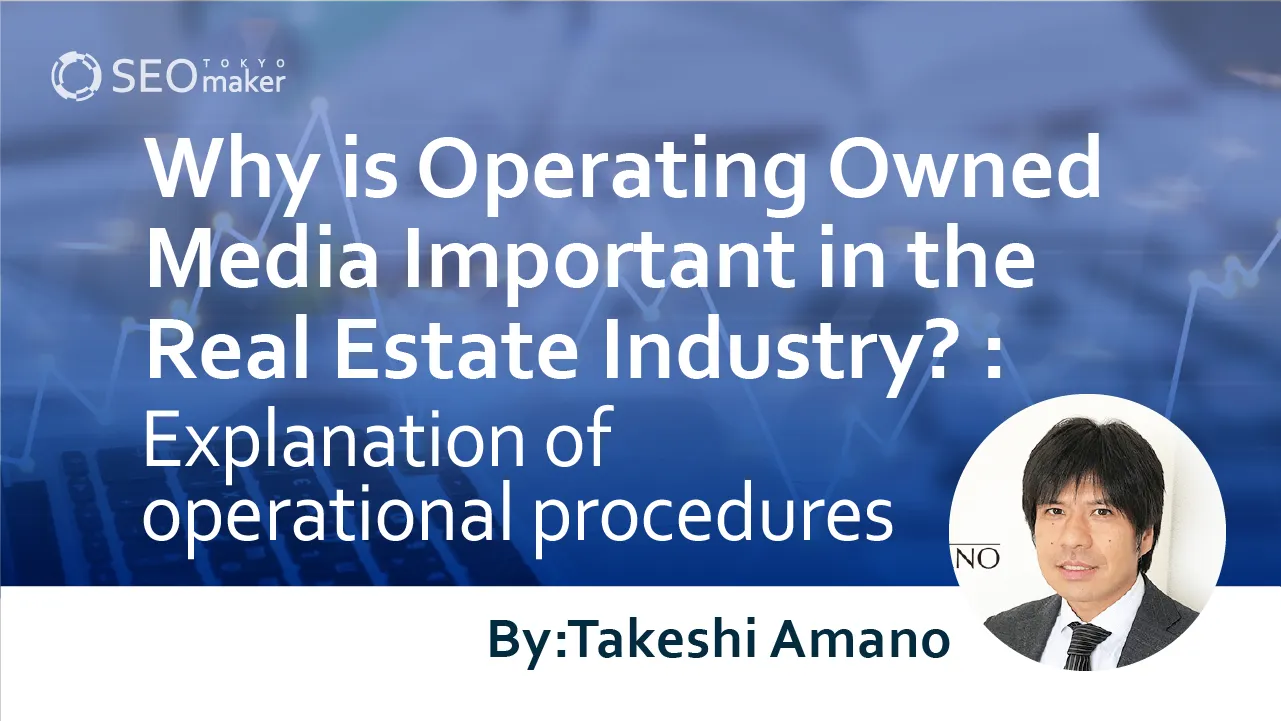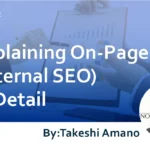Why is Operating Owned Media Important in the Real Estate Industry? : Explanation of operational procedures
contents

Owning media is crucial for companies in the real estate industry. But what exactly are the benefits of owning media in this field?
By operating owned media, real estate companies can reach potential customers whose needs may not be apparent. This is especially valuable for real estate firms looking to boost their customer base.
In this article, we’ll explore why owning media matters in the real estate industry and provide practical steps for building and managing it. If you’re considering media ownership for your real estate business, read on for insights.
Why is owning media important in the real estate industry?
Why is owning media important in the real estate industry?
Easily Earn Trust
With owned media, the goal is to produce content that addresses the concerns and uncertainties of search users, ultimately leading them from attraction to purchase and repeat business. Content that resolves the worries and doubts of search users can easily earn their trust.
For instance, imagine a real estate agency’s owned media addressing the search query ‘How to Find an Apartment.’ The content might include;
-Tips for finding high-quality apartments
-Characteristics of apartments to avoid
-Average costs of apartments
-Characteristics of real estate agencies to avoid
-Insider knowledge about apartments
For search users looking for an apartment, clear and expertly explained information like this can build trust and potentially influence their choice of real estate agency.
Therefore, owned media is essential for establishing trust with new customers.
Reduce Customer Acquisition Cost (CAC)
Owned media offers real estate businesses the opportunity to reduce Customer Acquisition Cost (CAC) by reaching potential customers who may not be actively searching.
In the real estate industry, Cost Per Acquisition (CPA) for listing advertisements targeting active customers trends to be high. For example, the CPA for ‘Inquiries about Rental Properties’ is generally around ¥10,000 to ¥15,000. This high cost is due to the competitive nature of the real estate industry, where competitors set high click prices.
While larger real estate companies may handle this competition, smaller enterprises may struggle to convert leads, leading to mounting advertising costs.
In contrast, owned media content can attract and convert a large number of potential customers, potentially lowering the CAC compared to listing advertisements. Additionally, unlike listing ads, owned media content remains available indefinitely. This means that creating content with strong customer attraction can further reduce CAC.”
How to Start Your Owned Media Journey
Let’s delve into the steps to kickstart your owned media venture.
Design Your Strategy
Before diving into creating your owned media, it’s essential to design a strategy. The strategic design of owned media is no different from the marketing strategies used by companies to bring their products or services to market.
While the possibilities are endless, here are some key points to decide on at the very least.
-Market Research: Determine the size of your target market and identify any unmet needs, etc.
-Owned Media Objectives: Set goals such as revenue targets or monthly inquiry counts.
-Persona: Define the characteristics of the individuals your owned media will target.
-Editorial Calendar: Plan when and what type of content to create, along with the frequency of posting.
-Operational Structure: Assign responsibilities for content creation, internal operations, and decide on the extent of outsourcing.
One common pitfall in owned media ventures is operating without a clear strategy. Therefore, when considering owned media, start by defining your goals and operational details.
Create Your Owned Media. There are two primary methods for creating owned media:
Hire a web design agency or freelancer. Build your site using existing tools (such as WordPress). The most traditional approach is to enlist the services of a web design agency or freelancer. While this option may come with a higher cost, it ensures a stable quality of website production.
Alternatively, outsourcing to a freelancer may vary in quality depending on individual skills but can be more cost-effective.
Another option is to use existing tools like WordPress to build your site. WordPress, being the most well-known tool, allows you to construct your owned media with just the costs of server and domain fees.
However, some basic knowledge of HTML and CSS is required. If you’re not familiar with these, it’s advisable to outsource the production.
Specific Operational Procedures for Real Estate Owned Media
Let’s take real estate-related keywords as an example and outline the specific operational procedures for owned media
-Create a Persona
-Develop a Customer Journey Map
– Identify Search Queries
-Write Articles that Answer Search Intent
-Continuously Improve Based on Access Analysis
Create a persona
Firstly, clarify the user profile your owned media will target. This specific user profile is known as a ‘persona.’ For instance, if a renovation company were to operate owned media, they might design the following persona:
Gender: Male
Age: 37
Occupation: Company Employee
Income: ¥4,000,000
Company: Manufacturing
Marital Status: Unmarried
Location: Nagano Prefecture
Education: Bachelor’s Degree
Hobbies: Baseball Fan
By setting up such a detailed profile, you can determine the specifics of your target audience. To design a persona, analyze existing customers or conduct interviews with potential customers
Creating a Customer Journey Map
Based on the information needs of the persona defined above, let’s create a customer journey map. A customer journey map visualizes the series of steps customers take leading up to a purchase, much like a journey.
Applying the above persona to the customer journey map, it would look something like this
-Awareness: Searching for the cause of a cold house, learns about the solution of ‘insulation renovation’ through the website.
-Information Gathering: Besides ‘insulation renovation,’ they are interested in researching other ways to improve home warmth.
-Comparison: After detailed research, discovers two more ways besides ‘insulation renovation’ to improve home warmth.
-Purchase: Considering cost-effectiveness, realizes that ‘insulation renovation’ is the best option and considers making a request.
Creating a customer journey map like this helps clarify which stage of information needs requires what type of content.
Identifying Search Queries
To create content, start by identifying search queries. Search queries refer to the words (or combinations of words) entered into search boxes like Google or Yahoo! When identifying search queries, imagine what words your target users might search for.
For instance, if the goal is to raise awareness of insulation renovation, you can identify queries like;
-Cold House
-Hot House in Summer
-Cold Floors in House, etc.
After identifying such search queries, you can then decide on the articles to write next.
Writing Articles that Address Search Intent
From the identified search queries, determine the keywords for article writing. At this stage, analyze the ‘search intent’ for each keyword.
Search intent refers to the purpose behind the words users enter into the search box. The role of content is to provide the best answer to this search intent.
For example, users searching for ‘cold house’ may have the following search intent:
-Despite using air conditioning for heating during the cold winter months, the house remains cold, making it uncomfortable to stay in.
-They want to understand the reasons behind their house being cold.
-They want practical solutions they can easily implement.
In response to such search intent, provide content like;
-One possible cause of a cold house is weak insulation.
-By implementing insulation renovation, you can live in a warm house even during the winter months, etc.
Be mindful to create content that provides the best answers to users’ search intent.
Related Article: The Importance of Search Intent in SEO! From Research Methods to Utilization.
Continuously improve through Access Analysis
Once you’ve posted content, it doesn’t end there. Analyze the traffic and aim for high-quality owned media by continuously improving.
It’s recommended to review articles with poor traffic by analyzing site visits and conversions and referring to content with good metrics. Additionally, two essential free tools for access analysis are
Google Analytics: A tool for analyzing site traffic. It provides detailed metrics like page views and unique users.
Google Search Console: A tool for analyzing search result impressions, backlinks, and site indexing status.
Three Points for Achieving Results with Real Estate Owned Media
Here are three key points to keep in mind when operating real estate-owned media.
Be Conscious of Conversion Points.
When creating real estate content, be aware of conversion points. Clear conversion points lead to clearer strategies and content.
Conversion refers to the ultimate goal of the site. For example, if a renovation company operates owned media, the conversion point could be ‘contracting renovations.’ They aim to attract potential customers and nurture them through content until they’re ready to request a renovation.
Create Useful Content for Daily Life
In real estate-owned media, focus on creating content that relates to users’ daily lives. Since the real estate industry is mostly B2C, content directly beneficial to users’ lives is essential.
For instance, if you’re a real estate investment company, don’t just promote the benefits of your products. When creating content about ‘real estate investment,’ it’s important to consider the following:
-Analyze the lifestyle of those interested in real estate investment.
-Present the benefits of real estate investment in daily life.
-Explain the drawbacks of real estate investment.
It’s important to create content that shows how purchasing your product affects users’ lives, putting themselves in their shoes.
Prioritize Building Trust
In the real estate industry, gaining trust from customers is crucial. This applies to owned media operations as well, as gaining trust from search users leads to higher conversion rates.
To gain trust through owned media, consider the following.
-Provide optimal answers to search users’ concerns and questions.
-Write with accurate information (and if necessary, specify trusted sources of information).
-Specify the author’s profile information.
-Specify the operating company, etc.
Especially in the real estate industry, where prices are high, include information that pediatrics users and focus on gaining trust.
Three Points to Note in Owned Media Operations
Understanding the following points is crucial to avoid failure in owned media operations
Not Immediate Results
Owned media doesn’t yield results immediately after starting operations. Continuity is crucial, so planning for the long term is the key to owned media management.
According to a survey conducted by Shueisha Inc., which operates the web media ‘MarkeZine’, 35.1% of respondents reported that it took ‘1 year or more but less than 2 years’ to feel the results. Conversely, only 8.8% of companies reported ‘less than 6 months’.
Therefore, it usually takes six months or more, and typically over a year, to see results from owned media operations. Rather than expecting short-term results, plan your budget and content strategy over a one-year span.
Source: 60% of BtoB companies are proactive in owned media / More than 30% of operating companies feel the effects for over a year [Basic Survey]: MarkeZine
Understanding SEO is Necessary
To achieve results in owned media operations, understanding SEO is necessary. Lack of SEO knowledge can lead to poor results, so be careful.
SEO, short for Search Engine Optimization,” is a marketing method to increase site visits from searches. SEO strategies mainly consist of “on-page optimization” and “off-page optimization.
-On-page optimization involves adjusting the site internally, such as improving page load speed and optimizing internal links.
-Off-page optimization involves acquiring backlinks.
As specialized knowledge is required, if your company lacks expertise in SEO, consider hiring specialized personnel or outsourcing.
Allocate Resources for Content Production
In owned media operations, content production is crucial. Since content production takes time, be sure to allocate resources accordingly.
There are two methods to allocate resources for content production: “in-house” or “outsourcing”. If possible, it’s recommended to produce content in-house. Employees are the most knowledgeable about your products or services, making in-house production ideal .
However, if there’s a lack of resources internally or expertise in SEO, consider outsourcing.
Summary
Owned media operations allow you to acquire and nurture potential customers through content, leading them to purchase. For the real estate industry, where trust is paramount due to high prices, owned media, which can acquire customers through content, is highly compatible. owned media operations have the unique advantage of reaching potential customers whose needs have not yet become apparent. Therefore, real estate companies looking to increase their customer base should consider posting content through owned media to acquire potential customers.










![What is a Description? Explaining the Meaning, Writing Style, and Changing Word Count – [2023 Edition]](https://www.switchitmaker2.com/en/wp-content/uploads/2024/09/what-is-description.webp)










